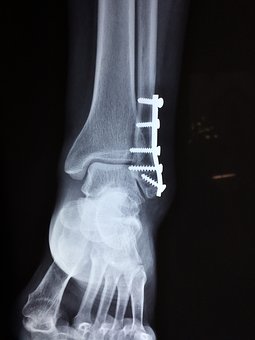Injuries in the feet are very common, particularly when you like playing soccer as you use your feet the majority of the time. The excessive running, the sliding, the tackling, the way you take a shot, the kicking, and sharp-turning movements can bring injury to your feet and body. One of the most common injuries in soccer is a broken bone (also known as a fracture) in the foot. The seriousness of a broken foot varies. It can be just a tiny crack or a complete break that results in two or more pieces. In severe conditions, broken bones can tear the skin and leave a gaping wound (also known as open fractures).

https://pixabay.com
Bones can break when something crushes, twists bends or stretches it. The toes are usually broken when you accidentally kick something too hard, the heels are usually broken when you fall from a height and land on your feet, and other bones in the foot can break when you twist or sprain your ankle. Most broken bones happen in an accident. But sometimes, tiny cracks form in bones over a long period of time from repeated stress, which is known as stress fractures.
The main symptom of a broken bone is pain and swelling. Many people do not recognize a broken foot because a strain or a sprain can also cause pain and swelling. Most of the time, you can compare your two feet to indicate the seriousness of an injury. The strongest indication of a broken foot is the deformity of your toe or any other area of your foot, such as an unusual bulge or your toe is pointing the wrong way. When there’s no deformity on your foot, it can be difficult to know whether a break has occurred, especially when it’s just minor cracks or breaks since they may not result in much pain. Other signs and symptoms that indicate a broken bone in your foot include:
- Feeling or hearing a snap when the injury happens
- Severe pain that you’re not able to walk (except in the case of a broken toe because it causes less pain and you may still be able to walk)
- A large open wound
- Feeling sick or dizzy, after the injury
- Tenderness when you touch the injury
- Cold and numb foot
- Bruising (usually blue) on the injury.

The first aid for a broken foot is following the RICE principle (Rest, Ice, Compression, and Elevation) and you can also take over-the-counter painkillers, such as ibuprofen and acetaminophen, to help relieve pain. However, when you suspect a broken foot or when the injury interferes with walking, seek medical assistance or go to the nearest emergency department immediately.
The doctor will ask about the injury and examine you. They may move your foot into different positions to check your range of motion, and you may be asked to walk for a short distance. If the symptoms suggest a break, your doctor may examine you with imaging tests, such as X-rays, bone scan, computerized tomography (CT), and magnetic resonance imaging (MRI).
The treatment will vary depending on the severity of the injury and which bone is broken. Your doctor may recommend anti-inflammatory drugs to reduce pain and swelling. If a bone is out of place, your doctor may perform a reduction procedure, where they manipulate the bone physically back into the correct alignment. The procedure is usually done under local anesthetic. In some cases, surgery may be needed to insert pins, plates, or screws to maintain proper position of your bones during healing.
To protect your foot while it heals, you may be asked to use crutches to help you walk, and your doctor will tell you whether or not you should bear any weight on your injured foot. A cast or a protective boot is sometimes provided to protect and immobilize the injured foot. After your bone has healed, it is usually important for you to loosen up stiff muscles and ligaments in your feet. You may need to see a physical therapist to teach you exercises to improve your flexibility and strength.